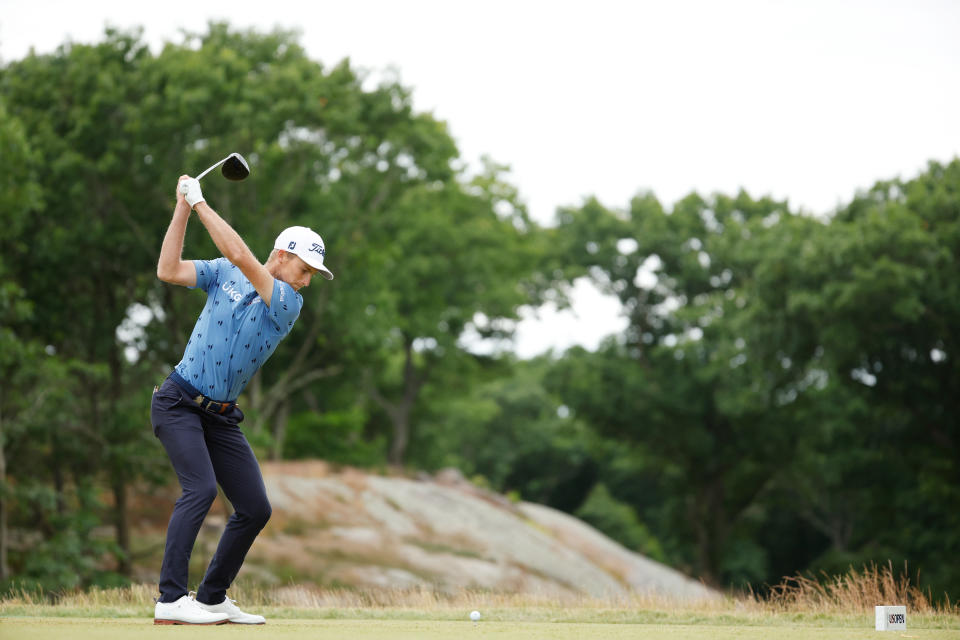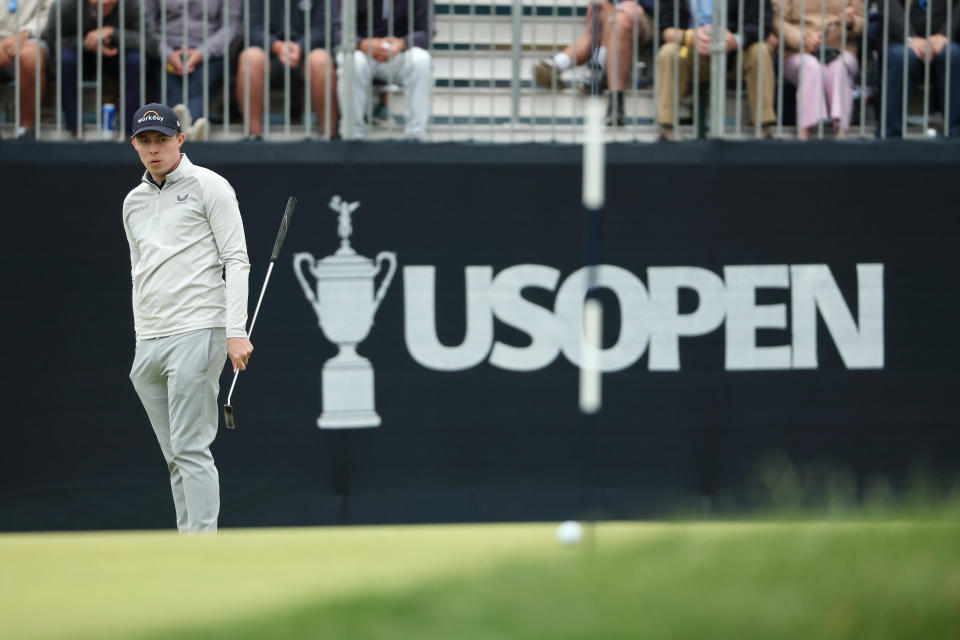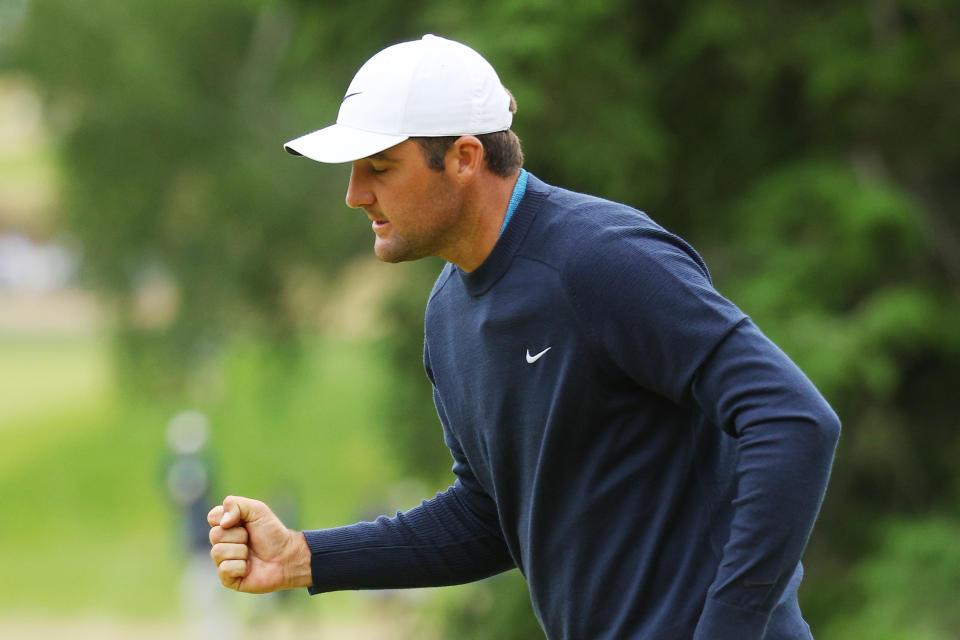Nine years ago, Matthew Fitzpatrick conquered The Country Club in Brookline, Mass., winning the U.S. Amateur as a stringy teenager. Sunday, with a bit more meat on his bones, and a lot more experience in them, he captured an even bigger prize: the U.S. Open.
Fitzpatrick defeated Will Zalatoris, who was the last man out for a second straight major.
The tournament, which had produced some spectacular golf all week long, truly hit fifth gear on the 13th hole Sunday. Fitzpatrick rolled in a 48-foot birdie putt to tie Zalatoris at -5. Zalatoris, meanwhile, faced a wicked 12-footer for par to hold onto a share of the lead. In a moment straight out of a Ryder Cup, he poured in the putt to stay level. Up ahead, Masters champion Scottie Scheffler, who had looked like he’d seize the tournament just a few holes earlier, missed a six-foot birdie putt on the 14th that would have put him into a tie for the lead.
The stakes for all three were enormous. Neither Fitzpatrick nor Zalatoris had ever won on the PGA Tour coming into the week. Scheffler, meanwhile, was looking to craft one of the great seasons in golf history, adding a U.S. Open trophy to his green jacket.
Zalatoris and Fitzpatrick were not able to take advantage of the par-5 14th, and they headed to the 15th tee all square. Fitzpatrick’s tee shot ended up amid the gallery along the right side of the fairway, while Zalatoris’ shot sank into the thick rough. After hustling the gallery out of the way, Fitzpatrick uncorked a brilliant approach that ended up 18 feet from the pin. Zalatoris, on the other hand, wrestled the ball out of the grass but nudged it into a bunker.
One birdie putt from Fitzpatrick, one par miss from Zalatoris, and just like that, Fitzpatrick had a two-shot lead with three holes to play. A few minutes later and two holes ahead, Scheffler rolled in a birdie putt to climb to within a stroke of Fitzpatrick’s -6.
But Zalatoris wasn’t done. His tee shot on the 209-yard par-3 16th was his finest of the week, leaving him just six feet for birdie. The often-wobbly putter rolled with purpose to chop a stroke of his own off Fitzpatrick’s lead.
Ahead on 18, Scheffler barely missed a 23-foot birdie putt and had to settle for a par to finish the day at -5. At that point, all the world No. 1 could do was wait and watch.
On 17, Zalatoris was 12 feet, two inches from the hole. His putt rolled 12 feet. Fitzpatrick was 11 feet, eight inches from the hole; his putt rolled 11 feet, eight inches … but just left of the cup. Two tap-ins later, and the two walked to the 18th tee with Fitzpatrick at -6, Zalatoris and Scheffler waiting right there at -5.
But on that 18th hole, Fitzpatrick made what could have been the worst decision of the tournament. With plenty of room in the fairway and a one-stroke lead, he ended up against the island in a left-side fairway bunker. His clutch escape just barely skirted the edge of the bunker and ended up on the green, 18 feet from the hole.
Zalatoris, in the fairway, had no choice but to go for birdie, and his approach spun back toward the pin to end up 14 feet from the hole.
Fitzpatrick, with the tournament on his putter, had the chance to win with a birdie, but just pushed it left.
Zalatoris had one putt to force what would be a second consecutive playoff for him … and barely missed.
The U.S. Open belonged to Fitzpatrick, but the crowd’s heart broke for Zalatoris.


Pre-tournament: LIV dominates the day
Golf, as a sport, entered the week in a crisis perhaps unprecedented in history. The U.S. Open is the first major to take place since the debut of LIIV Golf, the Saudi-backed breakaway tour that’s claimed some of the most famous names in golf. The PGA Tour suspended the players who joined LIV, including Phil Mickelson, Dustin Johnson, Bryson DeChambeau and Patrick Reed. But the USGA, American golf’s organizing body, permitted those who had already qualified to play in the 2022 tournament, setting off three days of press conferences that never strayed far from the topic of LIV Golf.
The USGA stiff-armed any talk of LIV-related suspensions … but also left the door open to bar LIV players from future tournaments. Both LIV and the PGA Tour could claim some measure of victory, but neither can rest easy going forward.
“I think it would be a lot of hypotheticals for me to get what LIV is going to be by the time we’re talking about this next year, but as we would do any year, we’re going to definitely reevaluate field criteria,” USGA CEO Mike Whan said. “We would any year. We will take a look at what the landscape looks like.”
Mickelson, in his first comments on American soil since he talked himself into golf exile in February, seemed a callow shell of his former gunslinging self.
“It’s nice to be back,” he said in a chastened voice. “It’s been four months. It’s been a necessary time and an opportunity for me to step away a little bit and put a little bit of thought and reflection into going forward and how to best prioritize things.”
Brooks Koepka claimed to be tired of talking about LIV, but given that it’s an existential threat to the way golf now operates, he’s in for a whole lot more LIV discussion.
“Legacy, reputation, at the end of the day that’s all you have,” McIlroy said on Tuesday. “You strip everything away, and you’re left with how you made people feel and what people thought of you. That is important to me.”


Thursday: Getting acquainted
Then the tournament began, and LIV faded quickly into the background – primarily because no LIV-aligned player made even a whisper on the leaderboard. For the second straight major, McIlroy bolted out of the gate, posting a -3 round that only Adam Hadwin topped.
Most of the best players in the field weren’t even born when The Country Club last hosted a U.S. Open in 1988, so they spent the early part of the week familiarizing themselves with the tight greens, thick rough and steep elevation changes of The Country Club.
One player with extensive experience in Brookline: Fitzpatrick. He finished the first day at -2, two strokes off the lead, and freely admitted that his previous success on the course helped him on Thursday.
“I’ve tried to have no expectations coming into this week,” he said. “I just want to enjoy the week, having obviously played so well here nine years ago. I’ve got great memories of the place, and the whole time I’ve been out, I see shots that I hit and I see the places I was. I think because of that I’m a bit more at ease. I’m just trying not to put any pressure on myself. It’s a golf course I know I can do well around, and I’m just trying to enjoy it.”
He would do exactly that.
Friday: Big names, big moves
The players fortunate enough to go in the early Thursday/late Friday wave enjoyed a very different golf course than their colleagues – calmer, softer and more manageable. The Celtics’ Thursday night loss to Golden State in the NBA Finals seemed to have broken everyone and everything in Boston, even The Country Club.
Collin Morikawa, who was in the midst of changing his swing on the fly, shared the halfway lead with Joel Dahmen at -5. One stroke back stood Rahm and McIlroy, who both managed to survive some in-round catastrophes to put themselves in position to capture another U.S. Open.
“I certainly don’t want it to be easy,” McIlroy said Friday. “I want guys to go out and shoot 65 so I have to go and shoot 64. That’s competition, and that’s at the heart of this game. I’m excited to be in that mix going into the weekend.”
One of the wilder moments in recent major history happened on Thursday, when MJ Daffue – who briefly reached -6 and led the tournament by three strokes – decided to hit off the deck of a hospitality tent. He would fade later in the tournament, but Daffue will always have a unique memory – and so will the people he nearly clobbered.


Saturday: The Country Club bites back
Chilly winds, dry greens and thick rough combined to make Saturday the toughest day of the week for the field. Morikawa, a two-time major winner, gagged up his worst round in a major of his career, a +7 debacle that ruined his hopes of snagging the third jewel of the career grand slam.
Fitzpatrick and Zalatoris, who had both paired up for an impressive run in last month’s PGA Championship, played their way into the final group by ending the day at -4. Both came away feeling fortunate they’d survived a day that had obliterated so many other challengers.
“This place is a beast,” Zalatoris said Saturday evening. “It’s just so easy to compound mistakes out here, which, of course, you can do that in major championships in general, but especially this one.”
Scheffler, meanwhile, appeared poised to run away with the tournament after a hole-out eagle on 8. But he then fell apart, going five-over across four straight holes to plunge down the leaderboard. He saved his day with a birdie on 17 and a lengthy ppar save on 18, leaving him just two strokes off the lead.
“The U.S. Open is very taxing, mentally and physically,” Scheffler said after the round. “I think that’s all part of what this makes this tournament so fun. You’re going to get tested all different kinds of ways, whether it be physically, mentally, whatever it is. This golf tournament is going to test you.” Indeed it does.
A coronation deferred
Scheffler, riding an astounding run of success, came into Sunday hoping to become the first player since Jordan Spieth in 2015 to win both the Masters and the U.S. Open. Early on Sunday, he looked like he was going to run away with the tournament, birdieing four of the first six holes to leap out to -6. He’d tied the overnight lead of -4 before Fitzpatrick and Zalatoris even teed off, then piled on another couple strokes to give himself a cushion.
But no lead was safe at The Country Club. No scorecard, either. The Country Club began picking off contenders, one by one. Hadwin ended up in the hay alongside the second hole, bogeyed and never got close to the lead again. Keegan Bradley, a hometown favorite who’d enjoyed a raucous ovation as he walked up 18 on Saturday night, bogeyed his first three holes to remove himself from the equation.
Rahm and McIlroy, who’d both played so well heading into Sunday, simply couldn’t get going at all. Rahm lived dangerously, leaving himself long putt after long putt, and the odds caught up with him. Bogeys started cropping up on his card on the fifth and eighth holes, and by the time he posted two in the first three holes of the back nine, he was effectively lost.
McIlroy, meanwhile, seesawed back and forth, alternating bogeys and birdies all afternoon long. He pinballed between even par and -2, unable to make up any ground on the leaders. McIlroy didn’t have his traditional one terrible round this major, but once again, he couldn’t put it all together at the most important moment.
Hideki Matsuyama, the 2021 Masters champion, roared in from nowhere to post a -5 round to finish at -3, enough to give the leaders something to eye for their final 90 minutes on the course. Morikawa also salvaged a measure of pride by firing a -4 round to finish at -2.
By the turn, though, it was clear the U.S. Open would be a three-man race. Zalatoris shook off some early struggles to birdie three of four holes on the front nine to surge back into contention. Fitzpatrick peppered in enough birdies to weather a bogey-bogey stretch on the start of the back nine. That brought them to the 13th hole, with opportunity in front of them both. It would take another five holes, but in the end, Fitzpatrick would walk away a winner, and Zalatoris would end up agonizingly close once again.
____
Contact Jay Busbee at jay.busbee@yahoo.com or on Twitter at @jaybusbee.
